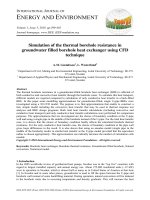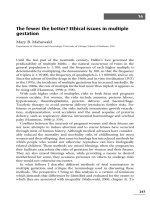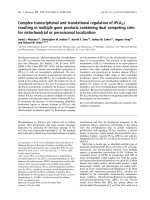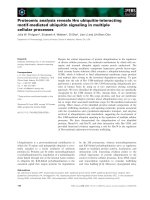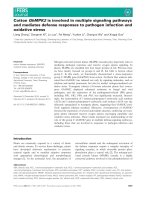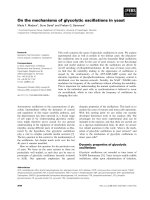resonant oscillations in multiple filled skutterudites
Bạn đang xem bản rút gọn của tài liệu. Xem và tải ngay bản đầy đủ của tài liệu tại đây (304.37 KB, 4 trang )
Resonant Oscillations in Multiple-Filled Skutterudites
L. GUO,
1
X. XU,
1,3
J.R. SALVADOR,
2
and G.P. MEISNER
2
1.—School of Mechanical Engineering and Birck Nanotechnology Center, Purdue University, West
Lafayette, IN 47907, USA. 2.—Chemical and Materials Systems Laboratory, GM Global R&D,
Warren, MI 48090, USA. 3.—e-mail:
Partially filled skutterudites were investigated by ultrafast spectroscopy using
a femtosecond laser system, which excites resonant oscillations due to the
host–guest interactions. To investigate the effect of individual guest elements
on phonon-mediated thermal transport, four skutterudite samples were
studied: three samples partially filled with Ba, Yb, and La, respectively, and a
fourth with a combination of these three elements. The spectrum of the
oscillations in the transient thermoreflectance signal was analyzed by Fourier
transformation. Comparison with the Raman spectra shows that different
guest elements cause resonant oscillations with different frequencies, which
can scatter phonons in different spectrum spans. This further demonstrates
that multiple guest elements can scatter a wider spectrum of phonons than a
single guest element at similar filling fractions, which results in lower lattice
thermal conductivity (j
L
) in skutterudites. These findings are consistent with
thermal conductivity measurements reported previously.
Key words: Multiple-filled skutterudite, ultrafast laser spectroscopy,
resonant oscillation, phonon transport
INTRODUCTION
Skutterudites have been considered strong can-
didates for intermediate-temperature waste heat
recovery applications, because they possess high ZT
values and good mechanical strength. The binary
skutterudite has intrinsic void cages in the crystal
structure, which allows insertion of guest atoms. It
has been shown that filling the void with guest
atoms at an appropriate ratio can significantly
reduce j
L
,
1–4
which together with the ability of the
fillers to increase the carrier concentration further
improves the thermoelectric performance of the
skutterudites. Regarding the mechanism of the
reduction in j
L
, investigation has been conducted
both theoretically and experimentally and different
possible explanations have been proposed. Bern-
stein et al.
5
performed molecular dynamics (MD)
simulations and showed that the anharmonic
interactions between host and guest atoms played
an important role in decreasing j
L
. On the other
hand, Baoling et al.
6
developed another potential
and used MD simulations to show that the decrease
in j
L
was more likely the result of the weaker
interatomic interactions among host atoms and
lattice distortions caused by guest atoms. The con-
cept of localized rattlers, proposed by Slack
7
to
describe the role of guest atoms in skutterudites, is
supported by a number of studies, including Raman
spectroscopy,
8
inelastic neutron scattering, heat
capacity measurements,
9,10
and infrared reflectance
spectroscopy.
11
Well-defined phase relations be-
tween guest and host dynamics were also found by
neutron spectroscopy and ab initio calculations,
12
which disagrees with the explanation based on
independent rattling of guest atoms. Ultrafast
spectroscopy of skutterudites was first used by
Wang et al., revealing that the resonant interac-
tions of the host–guest system may also cause the
reduction in j
L
.
13
It has been found that filling skutterudites with
multiple elements can suppress the lattice portion of
thermal transport more effectively than a single
element, which is usually explained by the notion
that different elements can rattle at different fre-
quencies and therefore scatter a broader range of
(Received July 7, 2012; accepted January 10, 2013;
published online March 5, 2013)
Journal of ELECTRONIC MATERIALS, Vol. 42, No. 7, 2013
DOI: 10.1007/s11664-013-2487-1
Ó 2013 TMS
1978
phonons.
3,4
Since the concept of rattling is still
open to question, this explanation needs further
investigation. In this work, we utilized ultrafast
spectroscopy to compare the resonant oscillations
of single- and triple-filled skutterudites, and the
results show that different elements can cause dif-
ferent resonant frequencies and that phonons with
a broader frequency span can therefore be scattered
by these oscillation modes.
EXPERIMENTAL PROCEDURES
Sample Preparation
High-purity Co and Sb shots were premelted by
induction at 1400°C in boron nitride crucibles, fol-
lowed by adding guest elements (Ba, Yb, La, or all
three) and Sb to reach the desired composition and
remelting at 1200°C for 5 min. These ingots were
then annealed at 750°C for 2 weeks to obtain
homogeneous samples of M
x
Co
4
Sb
12
(where M rep-
resents the guest element). The annealed samples
were ground into powder for spark plasma sinter-
ing. The resulting samples were dense and nearly
single phase with trace amounts of M
x
O
y
in samples
containing this filler. Ba, Yb, and La were chosen as
the fillers since they have been found to have sub-
stantially different vibrational frequencies and are
therefore capable of scattering a broad range of
phonons.
3,4
To elucidate the role of the individual
elements, three single-filled samples containing
each individual element were made, and a triple-
filled sample with all of these elements was also
prepared to see the effect of multiple-element filling.
The compositions of these samples were determined
by electron probe microanalysis to be Ba
0.26
Co
4
Sb
12.01
,Yb
0.21
Co
4
Sb
11.92
,La
0.14
Co
4
Sb
11.99
,andYb
0.05
La
0.05
Ba
0.08
Co
4
Sb
11.92
.
Ultrafast Spectroscopy and Raman Spectra
Measurements
An ultrafast laser system was used to excite and
detect the resonant interactions between the guest
atoms and the Co-Sb host lattice in the samples. The
pump-and-probe technique was used in a two-color
and collinear scheme to measure the transient
thermoreflectance (TTR) signals of the skutterudite
samples. The laser pulses were generated from a
Spectra Physics Ti:sapphire amplified femtosecond
system with central wavelength of 800 nm and
repetition rate of 5 kHz. A barium borate (BBO)
crystal was used to convert the wavelength of the
pump beam to 400 nm. The higher photon energy
ensures a higher kinetic energy of the photoexcited
carriers, which can strengthen the carrier–phonon
coupling. The probe had pulse duration (full-width
at half-maximum, FWHM) of 70 fs as measured by
autocorrelation, and the pump had pulse duration
(FWHM) of 140 fs as measured by cross-correlation.
The fluence of the pump was tuned to 193 J/m
2
. The
relative change of the reflectance of the sample
surface within several ps was recorded. The Raman
spectra measurements were taken with the excita-
tion laser at wavelength of 633 nm. Considering the
possible nonuniformity of the sample surface, the
frequencies of the concerned modes were measured
at seven points and the averages were used for
analysis.
RESULTS AND DISCUSSION
The normalized TTR signal of the Ba-filled sam-
ple is shown in Fig. 1 together with a magnified-
scale plot to show the oscillation of the signal. The
signals of the other three samples showed similar
trends and signatures, and for clarity are not
shown. Compared with the results for the p-type
-1
-0.5
0
0.5
1
Normalized ΔR/R
Delay/ps
(a)
-0.8
-0.78
-0.76
-0.74
-0.72
-0.7
-1 0 1 2 3 4 5 2.5 3 3.5 4 4.5 5
Delay/ps
(b)
Fig. 1. (a) Normalized TTR signal of the Ba-filled sample. (b) Oscillations in the TTR signal shown on a magnified scale.
Resonant Oscillations in Multiple-Filled Skutterudites 1979
misch-metal-filled skutterudites,
13
there are two
key differences. First, the background signals in
this work cross zero, which indicates that the car-
riers are n-type in these samples. Second, the
oscillations are much weaker in this work. This is
due to the much lower filling ratios, which agrees
with observations in previous work.
13
Also, the
n-type samples in the present study may have
smaller carrier effective mass, which can weaken
the carrier–phonon coupling and thus the lattice
oscillation strength.
Fourier transformation was used to analyze the
spectrum of the oscillations, and the result is shown
in Fig. 2. A bandpass second-order Butterworth
digital filter was applied to remove the carrier sig-
nal. The spectrum was normalized and shifted for
clarity. For the single-filled samples, there are two
dominating peaks for each, marked by vertical lines,
one near 150 cm
À1
(4.5 THz) and the other around
175 cm
À1
(5.25 THz). For the triple-filled sample,
there are two peaks near 150 cm
À1
. The peaks
around 175 cm
À1
change little with the different
filler species. In a previously published Raman
spectra study on skutterudites, a phonon mode
around this frequency was also found
14,15
and
identified as an F
g
mode.
15
The frequencies around
150 cm
À1
are close to the resonant frequencies
identified in Ref. 13 and are apparently affected by
the nature of the filler species. For confirmation,
Raman spectroscopy was also performed to identify
these frequencies. The Raman spectra of all the
samples are similar with regard to the positions of
the Raman peaks, and the result for the Ba-filled
sample is shown in Fig. 3 as an example. The only
mode detected near 150 cm
À1
is the low-energy A
g
mode, marked by a vertical line in the plot. The
frequencies from the TTR measurements together
with the frequencies of the low-energy A
g
modes
from the Raman spectra measurements are listed in
Table I, from which it is clear that the oscillations
observed in the TTR measurement are sometimes
spectrally close to, but are distinct from, the low-
energy A
g
mode.
From Fig. 2 and Table I, it is seen that the reso-
nant frequencies caused by Yb and La filling are
close in frequency and lower than that attributed to
Ba filling. For the triple-filled sample, two resonant
frequencies are detected, with one close to the res-
onant frequency caused by Yb or La filling and the
other close to that caused by Ba filling. Also, if the
magnitude of the peak around 175 cm
–1
is taken as
a reference, we can see that the resonant oscilla-
tions at the two frequencies for the triple-filled
0
1
2
3
4
80 100 120 140 160 180 200
Ba-filled
Yb-filled
La-filled
Triply-filled
Normalized intensity
Wave number /cm
-1
Fig. 2. Spectrum of the filtered TTR signals by Fourier transform.
700
800
900
1000
1100
1200
1300
1400
40 60 80 100 120 140 160 180 200
Intensity/arb.
Raman Shift/cm
-1
Fig. 3. Raman spectra of the Ba
0.26
Co
4
Sb
12.01
sample.
Table I. Comparison of the frequencies from the TTR measurements and the frequencies of the low-energy
A
g
modes from the Raman spectra measurements
Sample
Frequencies from TTR
Measurements (cm
21
)
Low-Energy A
g
Mode Frequencies from
Raman Spectra Measurements (cm
21
)
Ba
0.26
Co
4
Sb
12.01
155.9 145.8
Yb
0.21
Co
4
Sb
11.92
147.8 147.7
La
0.14
Co
4
Sb
11.99
146.3 147.5
Yb
0.05
La
0.05
Ba
0.08
Co
4
Sb
11.92
144.6/154.3 147.7
Guo, Xu, Salvador, and Meisner1980
sample are both weaker than the corresponding
single-frequency oscillation for the single-filled
sample. This is because, for the triple-filled sample,
the filling ratio of each element is lower and the
absorbed energy is distributed into a larger number
of oscillation modes. Therefore, we conclude that, by
filling the skutterudite with different elements,
different resonant frequencies can be created for the
host–guest system, which can scatter a broader
range of phonons, reducing j
L
.
CONCLUSIONS
TTR signals were obtained by ultrafast spectros-
copy, showing weak but distinguishable oscillations
in single- and triple-filled skutterudites. By ana-
lyzing the dependence of the oscillation spectrum on
the filling material and comparison with the Raman
spectra, we conclude that the oscillations detected
in the TTR signals reflect the resonant interactions
of the host–guest system caused by filling, and that
filling with different elements can create different
resonant frequencies. This work suggests that the
resonant interactions are also a possible phonon
scattering source in partially filled skutterudites,
and that multiple-element filling can suppress
phonon transport in skutterudites more effectively.
ACKNOWLEDGEMENTS
Support of this work by the National Science
Foundation (Award No. 1048616) is gratefully
acknowledged. The work at GM is supported by
GM and by the DOE under Corporate Agreement
DE-FC26-04NT42278.
REFERENCES
1. G.P. Meisner, D.T. Morelli, S. Hu, J. Yang, and C. Uher,
Phys. Rev. Lett. 80, 3551 (1998).
2. G.S. Nolas, H. Takizawa, T. Endo, H. Sellinschegg, and D.C.
Johnson, Appl. Phys. Lett. 77, 52 (2000).
3. X. Shi, H. Kong, C P. Li, C. Uher, J. Yang, J.R. Salvador, H.
Wang, L. Chen, and W. Zhang, Appl. Phys. Lett. 92, 182101
(2008).
4. X. Shi, J. Yang, J.R. Salvador, M.F. Chi, J.Y. Cho, H. Wang,
S.Q. Bai, J.H. Yang, W.Q. Zhang, and L.D. Chen, J. Am.
Chem. Soc. 133, 7837 (2011).
5. N. Bernstein, J.L. Feldman, and D.J. Singh, Phys. Rev. B 81,
134301 (2010).
6. B.L. Huang and M. Kaviany, Acta Mater. 58, 4516 (2010).
7. G.A. Slack, CRC Handbook of Thermoelectrics, ed. D.M.
Rowe (Boca Raton, FL: CRC Press, 1995), p. 407.
8. L.X. Li, H. Liu, J.Y. Wang, X.B. Hu, S.R. Zhao, H.D. Jiang,
Q.J. Huang, H.H. Wang, and Z.F. Li, Chem. Phys. Lett. 347,
373 (2001).
9. V. Keppens, D. Mandrus, B.C. Sales, B.C. Chakoumakos, P.
Dai, R. Coldea, M.B. Maple, D.A. Gajewski, E.J. Freeman,
and S. Bennington, Nature (London) 395, 876 (1998).
10. R.P. Hermann, R.Y. Jin, W. Schweika, F. Grandjean, D.
Mandrus, B.C. Sales, and G.J. Long, Phys. Rev. Lett. 90,
135505 (2003).
11. S.V. Dordevic, N.R. Dilley, E.D. Bauer, D.N. Basov, M.B.
Maple, and L. Degiorgi, Phys. Rev. B 60, 321 (1999).
12. M.M. Koza, M.R. Johnson, R. Viennois, H. Mutka, L. Girard,
and D. Ravot, Nat. Mater. 7, 805 (2008).
13. Y. Wang, X. Xu, and J. Yang, Phys. Rev. Lett. 102, 175508
(2009).
14. G.S. Nolas and C.A. Kendziora, Phys. Rev. B 59, 6189 (1999).
15. J.L. Feldman, D.J. Singh, and C. Kendziora, Phys. Rev. B
68, 094301 (2003).
Resonant Oscillations in Multiple-Filled Skutterudites 1981
